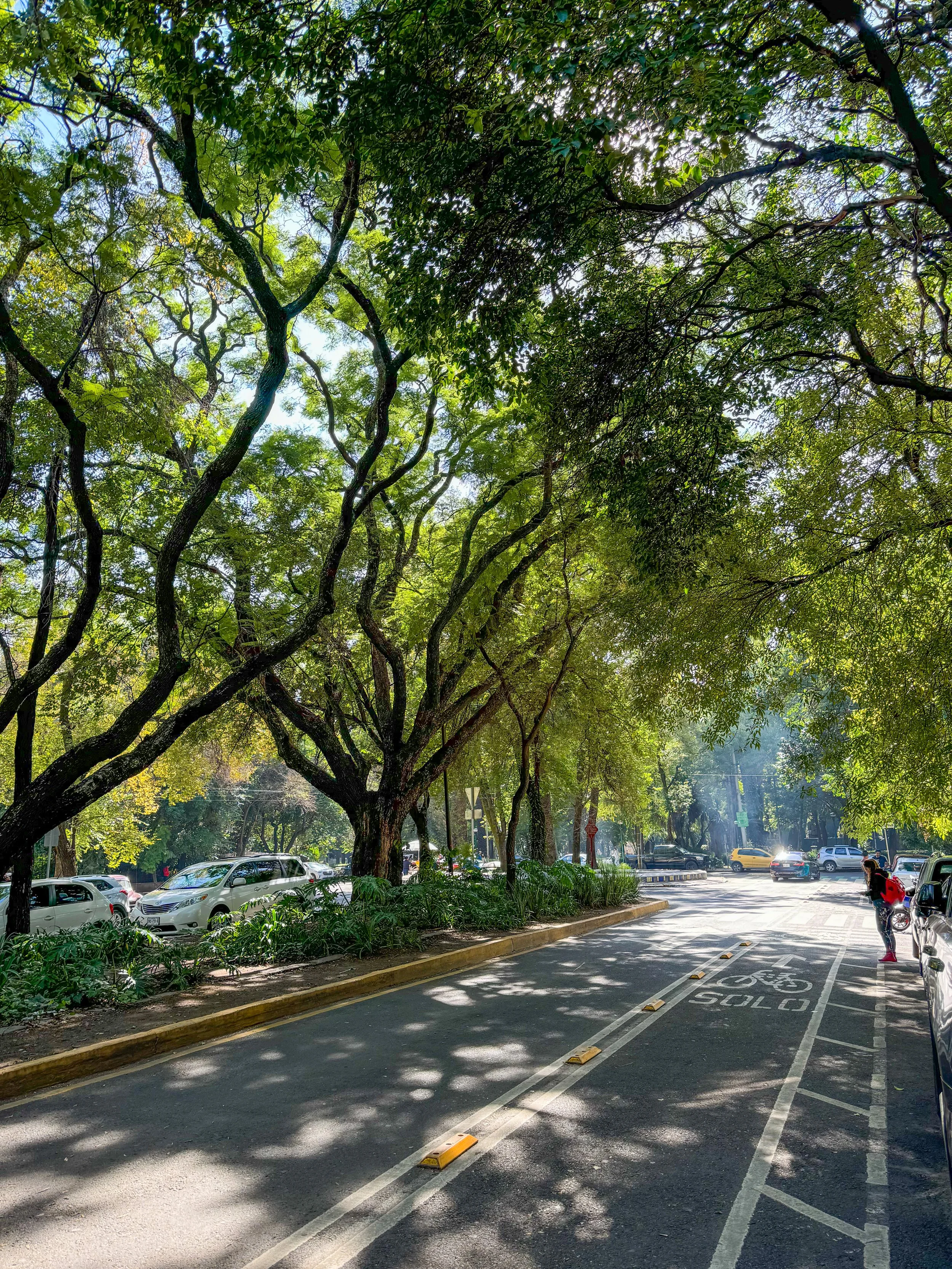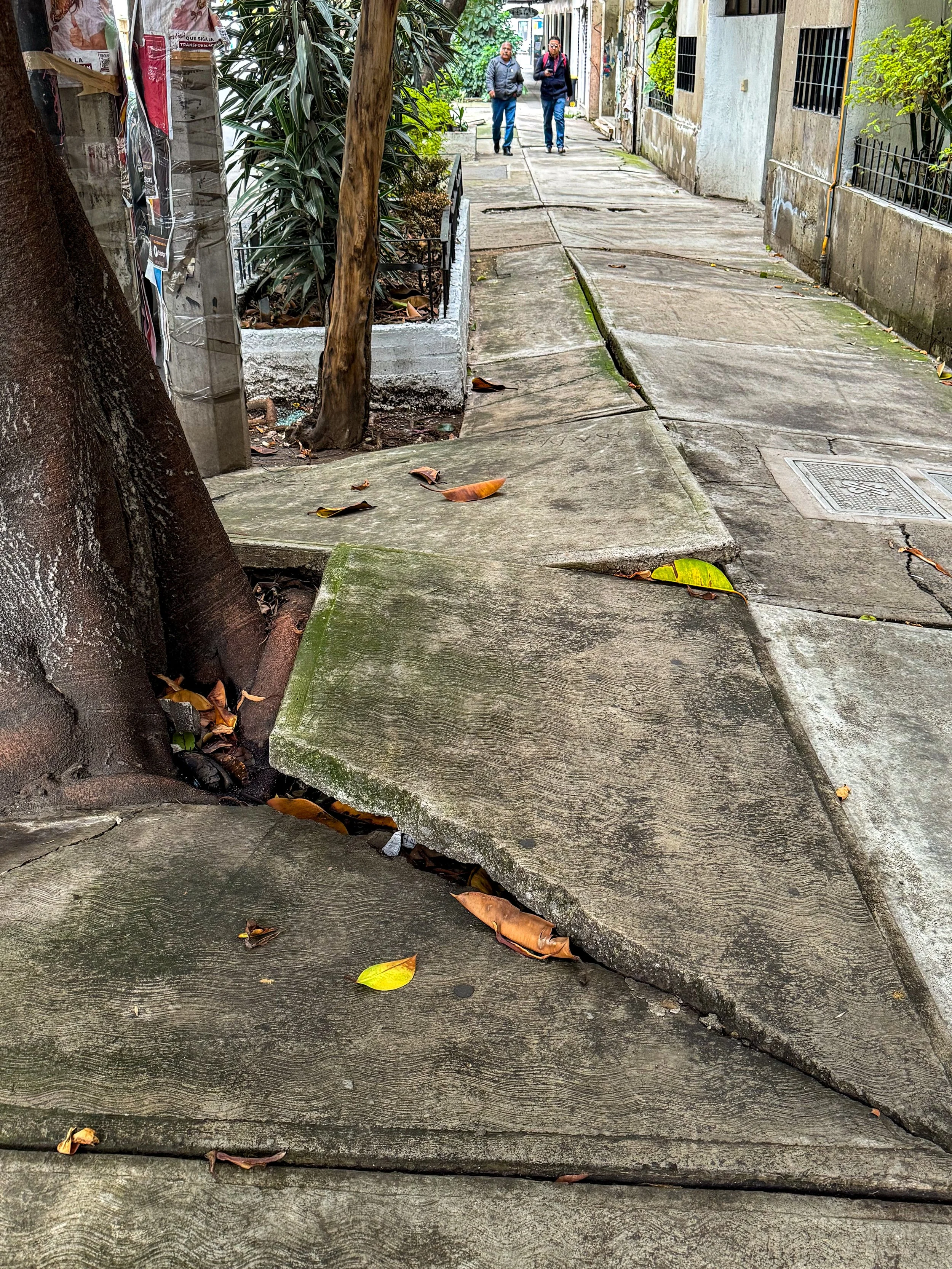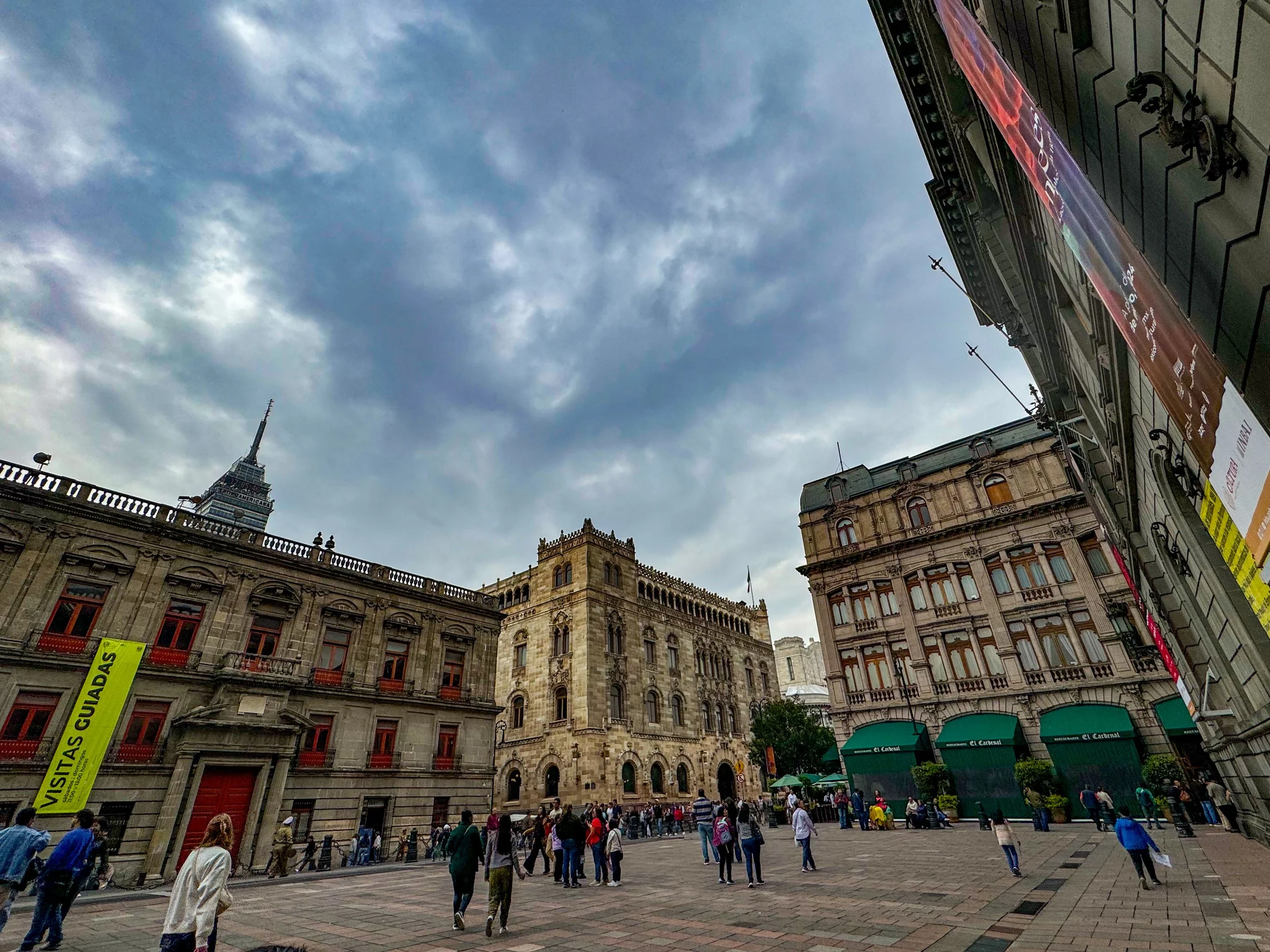CDMX FTW
Mexican Gang
October 7, 2024
We’ve been in Mexico City, known ubiquitously by its acronym CDMX (Ciudad de México), for a week now. It has been so overwhelming that I am not quite sure how to even begin writing about it.
As an American, the city presents me with a never-ending supply of contradictions. There is no question that we have been acculturated to believe many things about Mexico, most of them bad. Ironically, we have just as many images in our heads of beautiful beaches as we do of Hollywood-driven fear mongering imagery. So, after a week of experiencing this big, beautiful, and vibrant city, where everything is clean and dirty, and things work like they are supposed to, or they are metaphorically duct taped to work anyway, the lingering emotion is…relief? How unfair is that to a country and its people?
Many Americans first thought is, « is it safe? » We not been approached by anyone. Not once.
Instead, what we have seen here in the Condesa neighborhood, is a lush green neighborhood where streets are canopied by enormous rubber and other tropical trees. All of the house plants that you have purchased for yourself—fiddle figs, palmettos, philodendrons, ferns—well, they are just outdoor plants here, and surround you everywhere you go. There are beautiful parks and then the park-like walking paths in the center of the busiest streets.
La Condesa, Mexico City
And there are dogs. This is where Spot went when he left you as a child. They are all here in dog heaven. I do not mean to imply loose street animals, rather there are hundreds of dogs leading their humans around, behaving impeccably. Have I stepped in anything? There is nothing to step in. Everyone picks up after their dogs. Hey, you, Paris. Pay attention. What I really love to see are the professional dog walkers, of which there are quite a few. They can be found in one of the many parks—the one closest to us is Parque Espana—walking with upwards of 15 dogs together in military order. These walkers are the pack leaders, and the dogs know it. All sizes, all breeds. Nobody is tangled up in the myriad leashes. Nobody is barking. It’s like they all graduated from the César Míllan school of dog training. Once I saw three of these walkers all together chatting in the park. That’s right, about 40 dogs all together! You’d think it would be pure chaos, and shockingly they are all just chill. I saw one guy who put out these long yoga mats and had his dogs spaced out on them just sitting or lying down two feet apart. As if he told them only once what to do and they said, “Sir, yes, Sir!” Some 40 feet of dogs. I won’t forget that.
Marching in perfect order
Before I paint too rosy of a picture, let me compensate by explaining that the sidewalks are cracked and akin to a four-wheeler obstacle course. They are mended in all kinds of fashion with concrete, bricks, stones, or random steps just placed in the middle of the sidewalk. This is all caused by overgrown tree roots. Small price to pay for such beautiful surroundings, I suppose, but you must keep your head down when walking here or you might be visiting the Mexican health care system. The buildings are a mish-mash of different era architecture, most of them kind of rough looking, many under construction or some state of repair. These are interspersed with ultra-modern dwellings that have only appeared in the past decade. Then there are the wires hanging everywhere. You see a telephone pole with perhaps a hundred skinny wires running to a single point creating electric bird’s nest. I don’t think they are power lines, rather some kind of communication cables. There are water tanks on all the roofs. Everything needs a good coat of paint. To my American eyes, it’s a bit rough.
No ankle is safe
But there are also dozens of amazing coffee shops and restaurants interspersed, boutique clothing and shoe shops, little stores selling motorcycles and scooters, mini-markets both 7-11-style and gourmet, pharmacies, and even paint stores where you can get your gallons. What you don’t see are any big-box stores, with the lone exception of the Wal-Mart Express’, which are awesome, I have to say. I even found a shop selling only Mexican wines. Yes, Mexican wines. They make excellent wine in this country using primarily French and Spanish grapes. Just like the USA. There is a café culture with outdoor seating everywhere. Women walk alone day and night.
All of this creates a sanctuary in a city of 21 million people that feels calm and beautiful, and is tolerant of all kinds of people, including foreigners (There are many here), where people leisurely promenade the streets.
Record scratch.
Now we are in the Centro. And there is a massive protest. We don’t know what they are protesting, but there are lots of children and other young people, mixed in with adults. They all have signs we can’t read. Some people are dressed in costumes, some wear giant paper mache figures that stand above the crowds. Some are on stilts. There are colorful flags and music coming from every direction and endless voices screaming into microphones and bullhorns. The police have blocked the streets in every direction with pedestrian barricades trapping the protestors in place. The traffic can’t move, so drivers lean into their car horns with frustration. The nose combines, the din is endless. We are on foot after abandoning our Uber driver, weaving our way through the faces. Street vendors who see a golden opportunity are set up on every corner cooking tacos, churros, and blue corn quesadillas. I catch passing glimpses of bubbling meats braising together, piles of onions and peppers, fresh tortillas on the comals. The smell is overwhelmingly good. We want to stop, but there are just too many people. So, we keep moving towards our goal, which today happens to be the Museo Nacional De Artes. And it’s still a long way away.
Not a single person accosted us, or even noticed us on, really, as we made our way through the crowds. We never felt unsafe. If anything, we felt energized by the chance opportunity to be immersed in this sea of Mexican people of all types. I especially love the children’s faces. They look back at my Gringo face for a second before turning away. They seem much more interested in Chien’s Asian face.
Belle Arts Plaza
We finally make it to the Belle Arts Plaza where the beautiful museum building is, as well as the music hall. When we finally get to the front of the line to buy our tickets, they only take cash, and it turns out that I am low on pesos. Damn. So, back into the river of humanity we go looking for an ATM. They are not everywhere like home, so it takes us several blocks and multiple turns before we eventually succeed. We have noticed here that they only take cash or they only take cards, nobody takes both.
The museum is worth all of it.
When it’s time to go home we walk as far away from the crowds as we can looking for a decent pickup spot for an Uber driver to pull over. We are only four miles from our apartment, but on this day, we may have been 40 miles way, our legs and feet on fire. When we finally find the place we think works, we order the car. The app says 5 minutes. I didn’t sit down in that car, or anywhere, for another hour. The little car on my screen moving as if the driver were pushing it rather than driving.
But in that spot on the corner of José María Izazaga and Símon Bolivar (I won’t ever forget this, either) where we stood for an hour, we were treated to the reality of real Mexico City life. I should mention that it was Saturday, and we quickly figured out that this was shopping day. Everyone had something in their hands that they had just purchased. Toilet paper, curtain rods, I saw a man on the back of a motorcycle carrying a television. No, not in the box. Kids had ice cream and candy on sticks. I saw an older couple dressed very finely carrying flowers and tableware. All of CDMX’s population—every caste—was present living their lives. As if it were perfectly normal, motorcycles raced down the street, sometimes with many people on them, weaving between the cars, running red lights. There were young men pushing enormous carts of Chinese printed cardboard boxes stacked sky-high upon them. They were out in the street as if they were just another car sitting in traffic, waiting to make a right turn, sometimes two or three of them together. We’d see them return 20 minutes later with empty carts on their way back for another load. Suddenly a young man jumps in front of the cars at a red light and begins juggling three long machetes in hopes of collecting tips for his fearlessness. Nobody bats an eye. Well, I certainly did. The honking cars continue. The people move like rivers all round us. Everyone hustling.
This wasn’t swanky, lush Condesa. When we finally got back there two hours later, it suddenly looked very different. How quiet, how serene. This week we took a cooking class, and on a break, I asked our chef instructor if Condesa was like the Disneyland version of Mexico City, suspecting that this somehow wasn’t really CDMX, and she emphatically nodded her head yes. She said this is where you see police out, and the gentrification happening. I could see that now. It is a privileged area, and I felt very lucky to be there.
We’ll be here for another five days and tonight we have the excitement of eating at Pujol in the Polanco neighborhood. Even more privileged.





